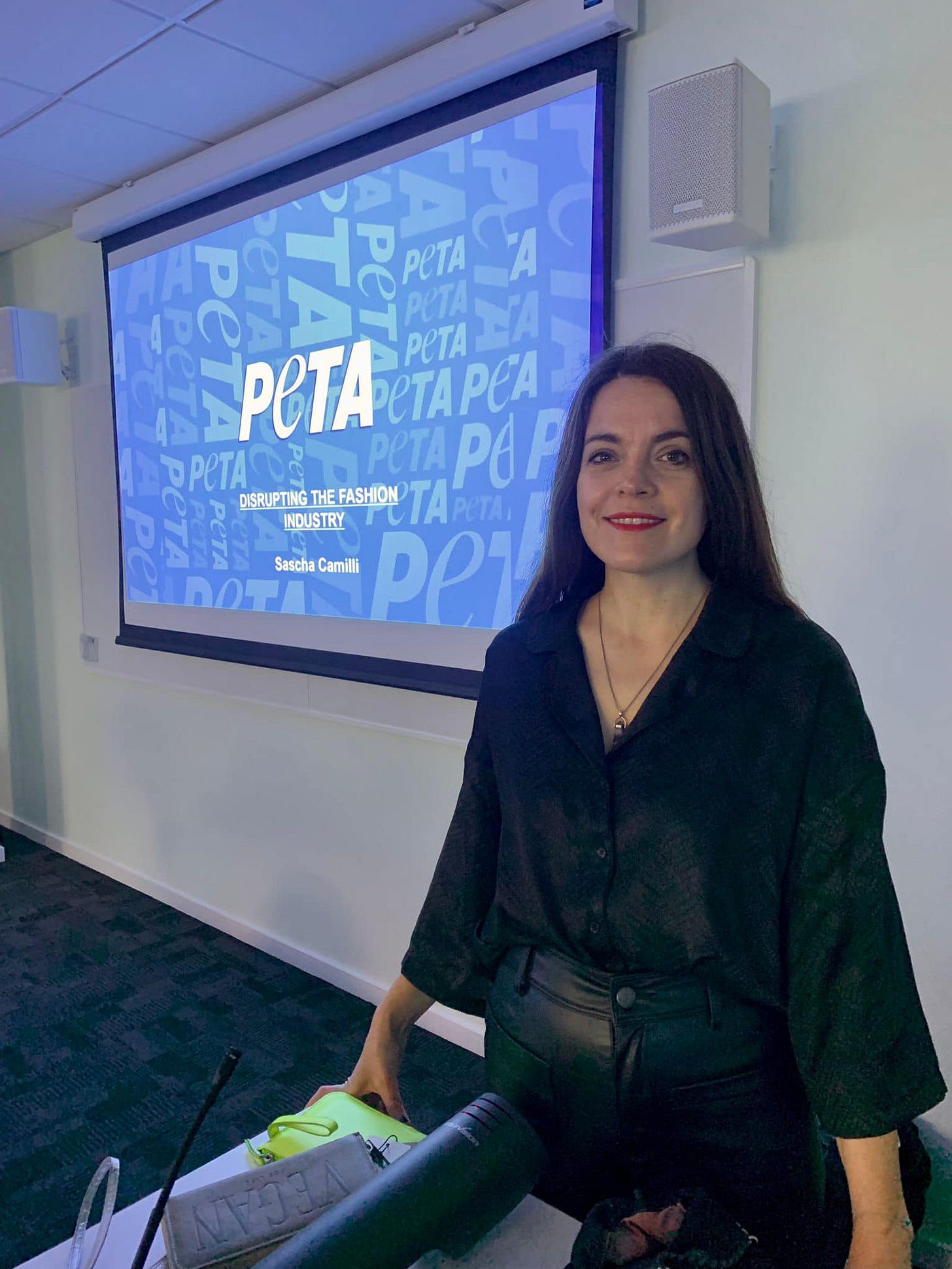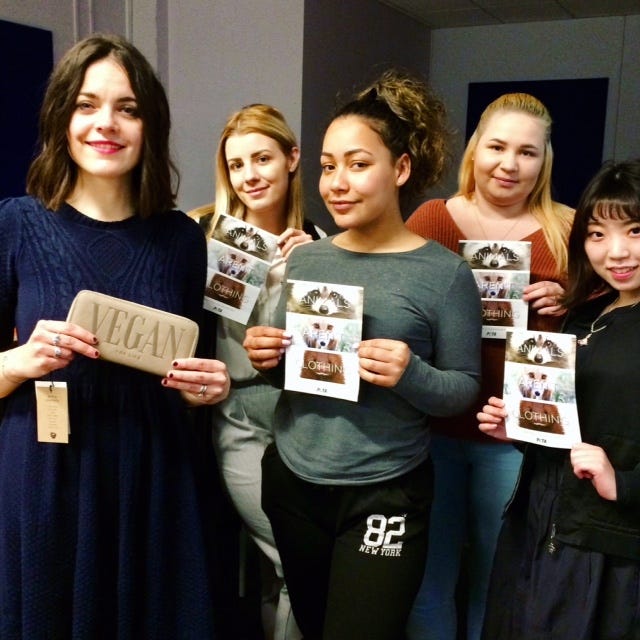Questions I'm Asked When I Lecture on Ethical Fashion
Putting compassion on the curriculum.
For a few years now, I’ve been regularly visiting fashion universities around the UK to guest-lecture about the use of animals in fashion.
In my lectures, I talk about the work that the organisation I am employed by (an influential animal rights group) does in the fashion industry, which includes exposing systemic cruelty to animals in the supply chain and promoting alternatives to wearing animals. This is one of the most rewarding parts of my job and I’m so grateful that I get to do it - but overall, I’m happy that it exists. When I was at fashion university (way back in the Stone Age), there was absolutely zero conversation about ethics in fashion. So it’s incredibly refreshing to see that the industry professionals of the future are encouraged to care about the planet.
After the presentation, I always invite students to ask questions - and most of the time, lots of questions come. Here are some of the most common ones, and what I usually answer.
Can vegan fashion be affordable?
Yes and no. Vegan fashion can be as cheap as a cotton t-shirt on Vinted or as pricey as Hermès bag made from mushrooms. But these questions often concern the plant leathers I showcase during my lectures, and here the answer is a bit more nuanced. Overall, price point tends to come down the more a material enters the mainstream, so simply put, the more common vegan materials become, the less they will cost. A bag made from grape leather probably won’t ever be as cheap as a Primark PU clutch, but that’s not the point of these materials. As they are built for durability (more on that later) and made to rival animal skins, they will always sit a bit higher on the price scale than the pleather you’ll find at a big fashion chain. That said, they are nowhere near the astronomic prices of, say, wild-animal skins, which can truly be bank-breaking. Today, I would say most plant leathers are at the price point of a mid-range animal leather.
But if we remove animals from the fashion industry, what will happen to the people who work in the trades?
As much as vegans would want it to happen, the animal-using industries won’t disappear overnight. If animals are removed from the fashion system, this will happen very gradually, which will allow people in the trade to retrain and encourage young people going into the workforce to choose a different path. Which could also benefit them: research shows that mental disorder levels are higher for animal farmers and dairy farmers than non-farmers, and PTSD levels among slaughterhouse workers are soaring. We’re not protecting humans by forcing them to stay in the animal-farming industry - quite the opposite.
But won’t it be equally bad for the environment if we grow tons of plants instead of farming animals?
Scalability is indeed an issue for several vegan fashion innovations. But aside from the fact that new-generation materials such as cactus leather are an enormous step forward in terms of sustainability compared to both animal skins and traditionally made faux leathers, there is also the question of whether we need to scale this much at all. As someone who has worked with fashion and ethics for over a decade, I’m constantly finding myself coming back to the idea that the one core thing that needs to change in fashion is that we need to make, buy and consume less. And obviously discard less, as a consequence. Scaling every new innovation to the production level we currently have shouldn’t be the goal, because the production level we currently have is what got us into this mess. If we want to lower the environmental impact of our wardrobes, we need to move away from the desire of constantly filling them with more and more.
I already own leather and wool - what should I do with it?
Pretty much every new vegan has been there. You have several options here. One is to simply sell the clothing - and no, there is nothing wrong with keeping the money. If you don’t feel like profiting from these garments, you can always donate the money to a charity. You could give the garments away to someone who will wear them. You could also donate the garments to a charity shop, but that comes with its own set of problems. Did you know that only 10-30% of all donated clothing is actually re-sold at charity shops? The rest is often shipped off to countries in the Global South, where it can disrupt local industries or create waste. So actually, what I would advise here is - controversial opinion alert - to simply keep wearing these pieces until they reach the end of their lifespan. This doesn’t make you any less vegan, and it is very much the ethical thing to do: the planet urgently needs us all to minimise waste, in any way we can.
Are vegan materials long-lasting?
The new crop of vegan leathers are created by companies whose aim is slow fashion. They aren’t in the business of churning out pleather jackets that will start flaking after a season at best. New-generation materials have been tested for durability because their objective is to rival animal leather. But we also need to keep in mind that these materials are so new that it’s still hard to determine real-life durability. I can say that I own a grape-leather bag that I’ve had for two years and it looks brand-new. I also have an apple-leather pouch that I’ve had for four years and it’s starting to look worn, but I’ve used it to death. In my wardrobe you can also find a corn-leather clutch that I’ve had for three years - not a scratch. So the answer is probably that durability is a goal, and like with many other things, we’re getting there. I can tell you one thing: you won’t have to deal with that tell-tale flake of cheap PU (the bane of many vegans’ lives before the blessed arrival of plant leathers).
Let me add something here, though - very often I get this question in the same lecture as the question about whether vegan leathers are expensive. I don’t think it’s reasonable to expect something to last a lifetime and also come at Boohoo prices. The two just aren’t compatible. I’m the first one to rage against luxury fashion’s awful markups (which have no reason to exist! literally), but on the other end of the spectrum, expecting long-lasting, high-quality materials to have a fast-fashion price point is also part of the problem.
Is there plastic in vegan leather?
Overwhelmingly: yes.
This is not the same as saying that vegan leather IS plastic though. Plant leathers are very different from 100% PVC or 100% PU. The plastic involved in them is usually just the coating - and (get ready for a big surprise that really shouldn’t be a big surprise) this often goes for animal leather too. I’m going to say it again: commonly, animal skins are coated in plastic for durability. Just like any natural material, a cow’s skin also rots when taken off the cow, so needs to be treated with something to make it last. However, plastic-free vegan leather does exist: a great example of this is Natural Fiber Welding’s plant-based leather called Mirum, which is entirely free from petroleum-based ingredients.
But my grandpa’s brother’s cat’s hairdresser’s cousin has a farm where the sheep are treated really well
It is likely that this farm isn’t a supplier to any big-name brands - the methods used to produce large volumes cannot afford to prioritise animals’ well-being. And the people getting their clothing only from these grandpa farms and eschewing any other, more widely available animal-derived fibres are exceedingly rare. Using the presumed existence of “small, nice” farms to justify continuing to partake in industries that are overwhelmingly unethical is not going to solve things. It is also pretty much a guarantee that the animals are still sent to the slaughterhouse when they are considered no longer useful for production. And many people might decide that they are fine with that (which breaks my heart). But it’s important to remember then that what happens at the slaughterhouse (trigger warning on the link) is the same for all animals, whether they came from a huge factory farm or a nice grandpa’s little passion project.
But if we end child labour, those families won’t be fed at all.
Child labour robs children of their childhood and often their education. It also sometimes hinders adult workers from negotiating better pay for themselves. I see the point of wondering whether child labour is some families’ only way, but we cannot be stuck in a space where we are constantly choosing between two evils. The end goal has to be to get children out of work and into education, and raise food security in the areas where child labour is prevalent. Ethically produced fashion can in fact help with this by ensuring that all workers in the supply chain are paid a living (not minimum) wage. Banning child labour and demanding more transparency in the industry is also a good way of empowering adult workers to increase their income, so that children no longer need to work.
Why aren’t mainstream brands using vegan materials?
They are! Stella McCartney is leading the way of course, but Chanel and Hugo Boss have also worked with leather made from pineapples, as has H&M. Ganni is working with plastic-free vegan fur. Karl Lagerfeld has made a bag with cactus leather, and, as mentioned above, even Hermès is selling mushroom leather.
The reason why brands are hesitant to move away from animal-derived materials is because there is still a perception of them as higher in quality. But bio-based material innovation is slowly chipping away at that.
What can I do to help?
There are countless steps you can take. Move away from buying clothing made using animals’ bodies - this step will save lives and help tackle the climate crisis. Another huge, huge step you can take is reduce your reliance on newly produced clothing. Choose second-hand where possible and keep the clothing you have for as long as you can. We all need to let go of the trend-led mentality of “this is in, this is out”. Find your personal style. Sign petitions, get in touch with brands you love and ask them for more ethical options. Support ethically minded brands if you do decide to buy new fashion. Spread the word. Talk to people you know. Post on social media. Start a Substack and write about it! Believe that what you wear can change the world - because it can.
On a final note, I’m very happy to say that I’m continuing my work with universities by collaborating with them to implement PETA’s material policy, which prohibits the use of fur, angora, wild-animal skins and ostrich feathers across fashion departments. Coventry University is among the first to sign, and more is to come!





This is so interesting, and so amazing you can educate the next generation of fashion students in this way! I'm really excited to see better quality sustainable plant leathers be developed and become mainstream - can definitely relate to all the flashbacks of flaking vegan pleather, the struggle has been real. Better options are long overdue
Hey Sascha, this is awesome. I'd love to hear one of your talks, and I'd also love to hear more about how you actually pitch to institutions to get them to let you speak! Keep up the righteous work.